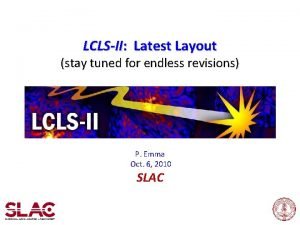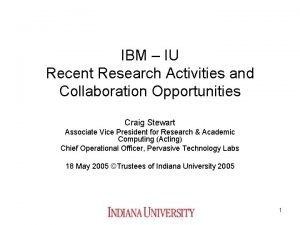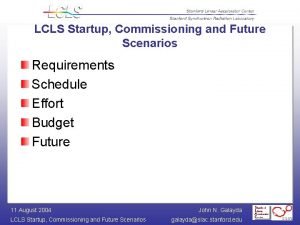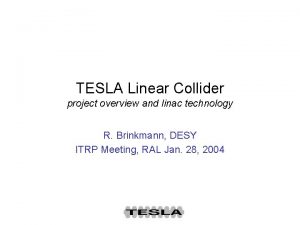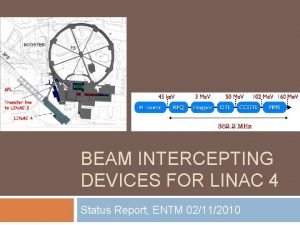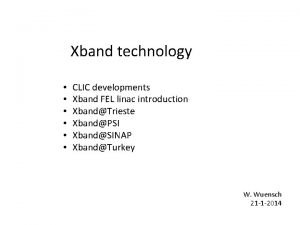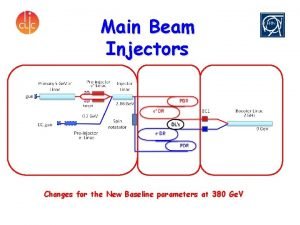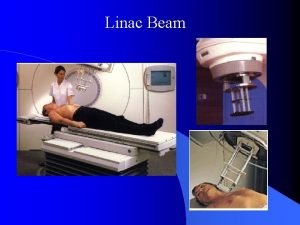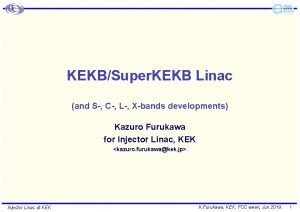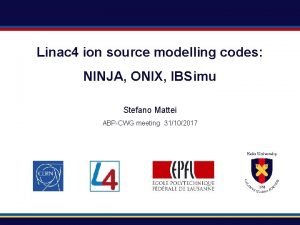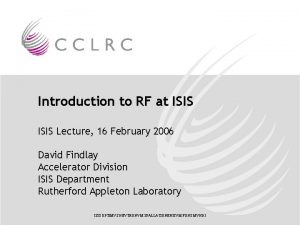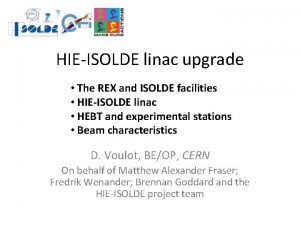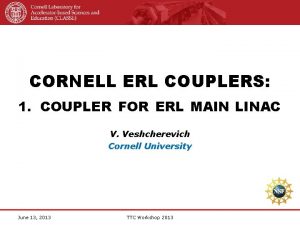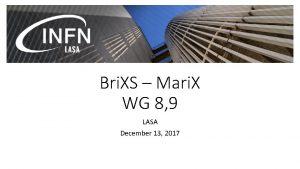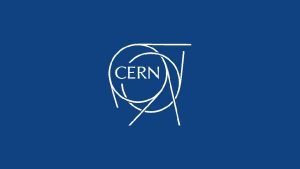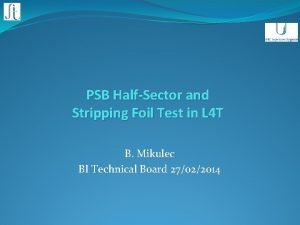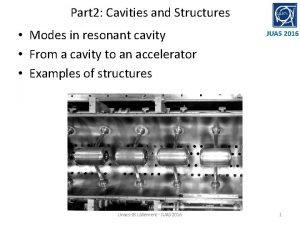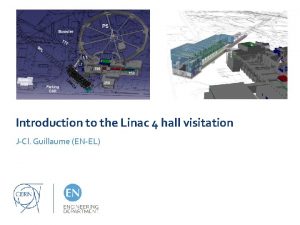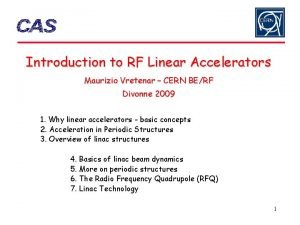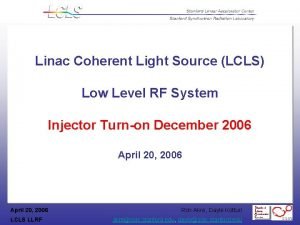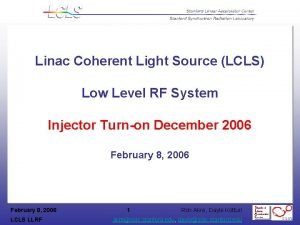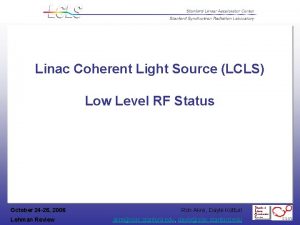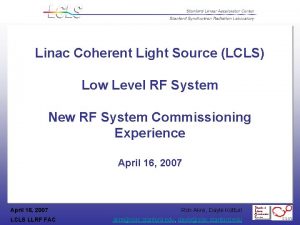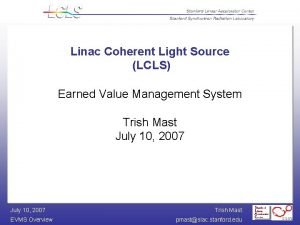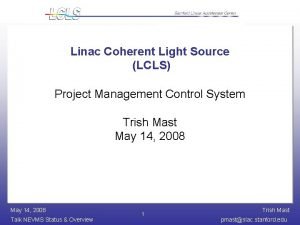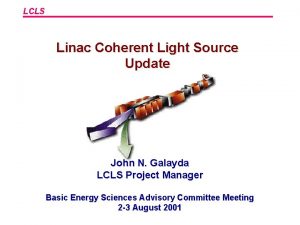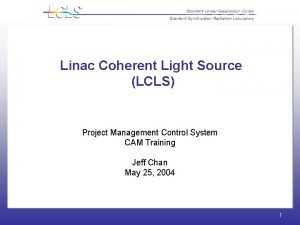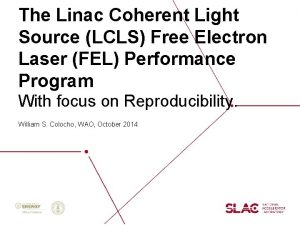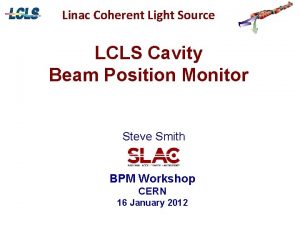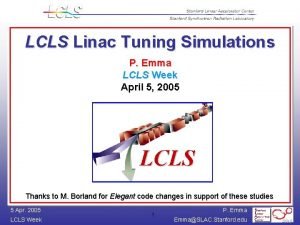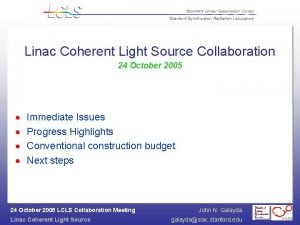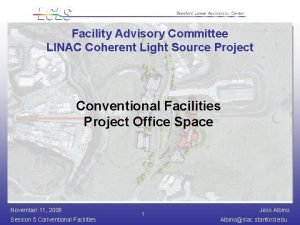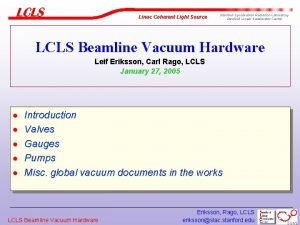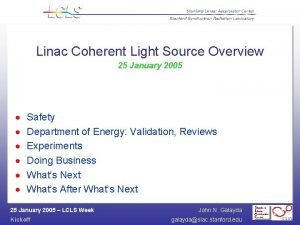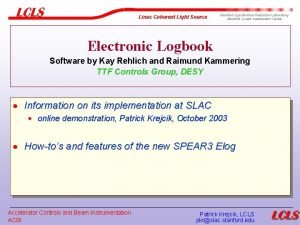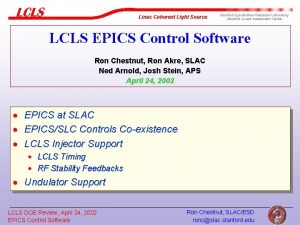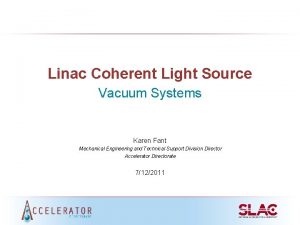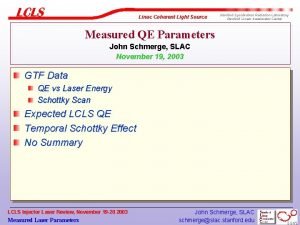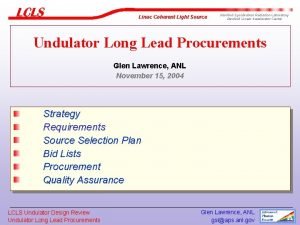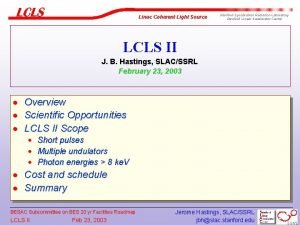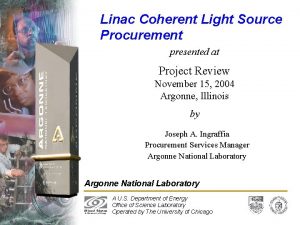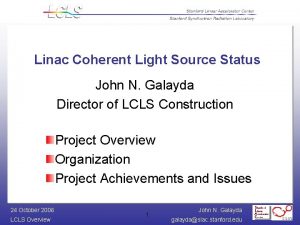Linac Coherent Light Source LCLS Low Level RF
























- Slides: 24

Linac Coherent Light Source (LCLS) Low Level RF Status October 24 -26, 2006 Lehman Review Ron Akre, Dayle Kotturi akre@slac. stanford. edu, dayle@slac. stanford. edu

Safety First and Second and Third…. . to Infinity Hazards in the LLRF system RF 1 k. W at 120 Hz at 5 u. S = 0. 6 Watts average, 2 Watt average amps at 2856 MHz, 60 W average amps at 476 MHz Hazards – RF Burns / Cataracts Mitigation – Avoid contact with center conductor of energized connectors. All employees working with LLRF systems are required to have the proper training. 110 VAC Connector Hazards - Shock Mitigation - Don’t touch conductors when plugging into outlet. All chassis are inspected by UL trained inspector. October 24 -26, 2006 Lehman Review Ron Akre, Dayle Kotturi akre@slac. stanford. edu, dayle@slac. stanford. edu

Status of Hardware for Injector Turn-on Linac Sector 0 RF Upgrade All 3 RF Chassis completed and Installed (Master Oscillator, Master Amp, PEP phase Shifter Control Module ready for test – higher phase noise levels if not installed Sector 20 RF distribution system Phase and Amplitude Controllers (PAC) – 5 units Phase and Amplitude Detectors (PAD) – 2 units Phased Locked Oscillator – Use SPPS unit for Turn On LO Generator – Complete - 75% tested – looks good so far Multiplier – 476 MHz to 2856 MHz – Complete 4 distribution chassis – Complete 102 MHz, 2056 MHz, 2830. 5 MHz Laser Phase Lock – Needs testing – Only high risk item Distribution Amplifiers – 10 W, 2850 MHz due Oct 25, 102 MHz Amp being built LLRF Control and Monitor System 1 k. W Solid State S-Band Amplifiers – 5 units – Design Complete, In Fab PAD – 12 units – 6 required for turn on PAC – 6 units Bunch Length Monitor Interface – Will use PAD to collect data Beam Phase Cavity Will use 2 channels of PAD Chassis Pill box cavity with 2 probes and 4 tuners – 2805 MHz 3 units Complete October 24 -26, 2006 Lehman Review Ron Akre, Dayle Kotturi akre@slac. stanford. edu, dayle@slac. stanford. edu

Status of Software for Injector Turn-on PAD Software Operational PAC Software Operational Local Feedback (in VME) Data analysis shows simple feedback algorithm will work. Optimization of algorithm continues. Time measurement: measure time needed for data acq, for transfer to VME, for VME processing, for transfer to PAC. Time measurement: needed for multiple local loops. Eg. Measure scalability from 1 to N instances. RF Gun Temperature Feedback In Design Calibration and Test Operational Host Applications In progress (This means we are working on specifications. ) Storing of boot params, serial numbers, etc in flash or on the board for PAD and PAC October 24 -26, 2006 Lehman Review Ron Akre, Dayle Kotturi akre@slac. stanford. edu, dayle@slac. stanford. edu

Status of Documentation + Reviews LLRF Control Design Specification This Engineering Specification Document was signed off by Project Office on 9/27/2006. LLRF Final Design Review This review was held on 9/19/2006. The scope of the review covered: RF Distribution Reference System for Injector Commissioning RF System for Injector Commissioning PAD PAC VME The goals of the review were: Injector RF turn on is January 3, 2007. The designs of the prototype PADs and PACs have been built and tested. Fabrication is scheduled for October, 2006. Please review analysis of test data and the proposed design and comment on the proposed systems' ability to meet LCLS specifications. Review our test plans and suggest improvements October 24 -26, 2006 Lehman Review Ron Akre, Dayle Kotturi akre@slac. stanford. edu, dayle@slac. stanford. edu

LCLS Layout P. Emma October 24 -26, 2006 Lehman Review Ron Akre, Dayle Kotturi akre@slac. stanford. edu, dayle@slac. stanford. edu

LCLS RF Jitter Tolerance Budget Lowest Noise Floor Requirement 0. 5 deg X-Band = 125 f. S Structure Fill time = 100 n. S Noise floor = -111 d. Bc/Hz @ 11 GHz 10 MHz BW -134 d. Bc/Hz @ 476 MHz 0. 50 X-band XRMS tolerance budget for <12% rms peak-current jitter or <0. 1% rms final e− energy jitter. All tolerances are rms levels and the voltage and phase tolerances per klystron for L 2 and L 3 are Nk larger, assuming uncorrelated errors, where Nk is the number of klystrons per linac. P. Emma October 24 -26, 2006 Lehman Review Ron Akre, Dayle Kotturi akre@slac. stanford. edu, dayle@slac. stanford. edu

Slow Drift Tolerance Limits (Top 4 rows for De/e < 5%, bottom 4 limited by feedback dynamic range) Gun-Laser Timing Bunch Charge Gun RF Phase Gun Relative Voltage L 0, 1, X, 2, 3 RF Phase (approx. ) L 0, 1, X, 2, 3 RF Voltage (approx. ) (Tolerances are peak values, not rms) 2. 4* 3. 2 2. 3 0. 6 5 5 deg-S % P. Emma, J, Wu * for synchronization, this tolerance might be set to 1 ps (without arrival-time measurement) October 24 -26, 2006 Lehman Review Ron Akre, Dayle Kotturi akre@slac. stanford. edu, dayle@slac. stanford. edu

Linac Sector 0 RF Upgrade LCLS must be compatible with the existing linac operation including PEP timing shifts Master Oscillator is located 1. 3 miles from LCLS Injector 1. 3 Miles to LCLS Injector Measurements on January 20, 2006 at Sector 21 show 30 f. S rms jitter in a bandwidth from 10 Hz to 10 MHz PEP PHASE SHIFT ON MAIN DRIVE LINE October 24 -26, 2006 Lehman Review MDL RF with TIMING Pulse – Sync to DR Ron Akre, Dayle Kotturi akre@slac. stanford. edu, dayle@slac. stanford. edu

RF Distribution Lab vs. MDL Measurements Existing Linac MDL Sector 0 LCLS Reference System Lab Measurements 126 f. S rms Jitter 10 Hz to 10 MHz 20 f. S rms Jitter 10 Hz to 10 MHz If PEP IQPAU Chassis is not commissioned we may not meet LCLS specifications October 24 -26, 2006 Lehman Review John Byrd LBNL Ron Akre, Dayle Kotturi akre@slac. stanford. edu, dayle@slac. stanford. edu

Sector 20 RF Distribution MDL from Sector 0 LO and 102 MHz resync by adjusting 2856 MHz PAC while monitoring S 21 2856 MHz Laser resync with laser PAC while monitoring difference in 119 MHz laser and FIDO out October 24 -26, 2006 Lehman Review Ron Akre, Dayle Kotturi akre@slac. stanford. edu, dayle@slac. stanford. edu

Lab Test Setup Reference, PAC, PAD The LCLS RF system duplicated in the lab and used for testing of PADs and PACs. At least two of each frequency generation chassis is built to measure phase noise levels. Most components will have development chassis which can be used as a spare. There is only one Dayle, spare is not in the budget. October 24 -26, 2006 Lehman Review Ron Akre, Dayle Kotturi akre@slac. stanford. edu, dayle@slac. stanford. edu

LCLS New Reference System Lab Measurements Lab Tests Show Reference System Noise Levels Meet All LCLS Requirements 2856 MHz = 70 f. Srms 2830. 5 MHz = 70 f. Srms 2856 MHz : 22 f. Srms 10 Hz to 10 MHz 2830. 5 MHz : 22 f. Srms 10 Hz to 10 MHz 25. 5 MHz : 152 f. Srms 10 Hz to 1 MHz 102 MHz : 281 f. Srms 10 Hz to 10 MHz 25. 5 MHz = 2 p. Srms 102 MHz = 2 p. Srms John Byrd - LBNL October 24 -26, 2006 Lehman Review Ron Akre, Dayle Kotturi akre@slac. stanford. edu, dayle@slac. stanford. edu

RF Cable Routing All cables are routed from devices in temperature stabilized area to the centrally located, temperature stabilized, RF Hut in the linac gallery. RFHUT Cables run down through penetration 20 -17 which is enclosed by the RF Hut October 24 -26, 2006 Lehman Review Picture taken from Carl Rago’s Talk Ron Akre, Dayle Kotturi akre@slac. stanford. edu, dayle@slac. stanford. edu

RF System Cables / Specifications LCLS Specifications: Laser, RF Gun – 2. 3 p. S L 0 A, L 0 B, L 1 S, L 1 X, L 2, L 3 – 5 p. S October 24 -26, 2006 Lehman Review Ron Akre, Dayle Kotturi akre@slac. stanford. edu, dayle@slac. stanford. edu

SLAC Linac RF – New Control The new control system will tie in to the IPA Chassis with 800 W of drive power available. The RF Reference will be from the new RF reference system. Solid State Sub-Booster Existing System October 24 -26, 2006 Lehman Review PAC I and Q will be controlled by the PAC chassis, running 16 bit DACs at 102 MHz. Waveforms to the DACs will be set in an FPGA through a microcontroller running EPICS on RTEMS. Ron Akre, Dayle Kotturi akre@slac. stanford. edu, dayle@slac. stanford. edu

Linac Station 21 -1 Tests (Aug. 18, 2006) October 24 -26, 2006 Lehman Review Ron Akre, Dayle Kotturi akre@slac. stanford. edu, dayle@slac. stanford. edu

Linac 21 -1 Test Set-up Power Coupled out from 476 MHz MDL drives a 476 MHz Amplifier which feeds a 6 X Multiplier from 476 MHz to 2856 MHz. The 2856 MHz out drives both the LO generator and the PAC. The 2830. 5 MHz LO and 102 MHz CLK Generator supplies the LO and CLK to the PAD. A CLK output of the PAD drives the PAC CLK. The PAC output drives the SSSB. The SSSB drives the existing IPA chassis The klystron output coupler is used to measure phase and amplitude with the new PAD. October 24 -26, 2006 Lehman Review Ron Akre, Dayle Kotturi akre@slac. stanford. edu, dayle@slac. stanford. edu

Linac 21 -1 Test Results Tests were done in the gallery with no temperature regulation on cables. Average RMS value of 2 second sliding average is 0. 068 degrees. Exponential Smoothing Yields the Following Results. Lowest noise is with a time constant of about 2 points. October 24 -26, 2006 Lehman Review Ron Akre, Dayle Kotturi akre@slac. stanford. edu, dayle@slac. stanford. edu

LLRF Commissioning – no high power RF, no beam Low Level Lab Tests and Calibration PACs and PADs Set at Operational Temperature PAC Tests and Calibration – SSB Modulator : Set offsets and gain PAD Tests ADC Board – SNR Cross Talk – Sine Wave histogram Chassis – Two Tone or Single Tone - SNR, Noise Floor, IP 3 Installation of PACs and PADs – Other systems required to be complete LLRF Racks - installed Water System Trigger system AC Rack power Test RF Cables - Measure Attenuation and Phase Stability Installation of Solid State Sub-Boosters (SSSB) Installation of RF VME Crate Installation of network switches Get devices booting from afsnfs 2 Test VME connectivity to PAD by sending I and Q avgs. Connection of PADs, PACs, and VME IOCs to network Initial Set-up of PAC triggers Align 119 MHz trig to 102 MHZ clocks for PACs and PADs PAD Calibrations Enter channel calibration factors (APCs, Power Scale Factors – coupler ratios…) PAC Calibration with spectrum analyzer Calibration with PAD channel Phase Noise Measurements 102 MHz Clock : 2830. 5 MHz LO : 2856 MHz RF : Laser Lock to RF October 24 -26, 2006 Lehman Review Ron Akre, Dayle Kotturi akre@slac. stanford. edu, dayle@slac. stanford. edu

LLRF Commissioning - high power RF, no beam Timing System setup Line up PAC and PAD triggers to existing modulator triggers Adjust PAC waveforms for 6 Klystron stations Adjust PAD window length and offset to fit waveform Commission local Feedback loops Gun Tune Gun Phase Gun Amplitude L 0 A Phase L 0 A Amplitude L 0 B Phase L 0 B Amplitude Tcav Phase Tcav Amplitude L 1 S Phase L 1 S Amplitude L 1 X Phase L 1 X Amplitude Test Standby Timing and BCS functions October 24 -26, 2006 Lehman Review Ron Akre, Dayle Kotturi akre@slac. stanford. edu, dayle@slac. stanford. edu

LLRF Commissioning - high power RF, with beam Timing System setup Adjust PAC and PAD triggers to align waveforms to beam time 119 MHz PAD/PAC triggers must move in increments of 14 ticks to keep all phases aligned (~117. 6 n. S). PAD window must move in increments of four 102 MHz cycles to keep phase reading the same. (~39. 2 n. S). Increments of 9. 8 n. S will cause 90 degree phase shifts in readings. Commission local Feedback loops Gun Phase - Phase to beam (Rotate phase to get max beam energy) Gun Amplitude - Check Cal (RF power to maximum energy gain) L 0 A Phase - Phase to beam L 0 A Amplitude - Check Cal L 0 B Phase - Phase to beam L 0 B Amplitude - Check Cal Tcav Phase - Phase to Beam Tcav Amplitude - Check Cal L 1 S Phase - Phase to Beam L 1 S Amplitude - Check Cal L 1 X Phase - Phase to Beam L 1 X Amplitude - Check Cal October 24 -26, 2006 Lehman Review Ron Akre, Dayle Kotturi akre@slac. stanford. edu, dayle@slac. stanford. edu

Host Applications Generic Correlation plots Calibration of power levels using beam energy Distribution System Rotate Phase 360 degrees Monitor Phase Errors in Dividers Correct Divider Phase Errors PAC Calibration Mode Operation Generate and Load Waveforms Panels for Phase and Amplitude Adjustment PAD Testing Crosstalk, SNR, Noise Floor Sine Wave Histogram Panels for Phase and Amplitude Monitoring Local Feedback Control Panels October 24 -26, 2006 Lehman Review Ron Akre, Dayle Kotturi akre@slac. stanford. edu, dayle@slac. stanford. edu

END of TALK October 24 -26, 2006 Lehman Review Ron Akre, Dayle Kotturi akre@slac. stanford. edu, dayle@slac. stanford. edu
